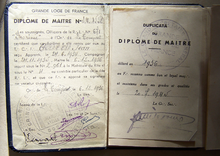Therefore sign
| ∴ | |
|---|---|
Therefore sign | |
| In Unicode | U+2234 ∴ THEREFORE (∴, ∴, ∴) |
| Related | |
| See also | Similar signs (below) |
In logical argument and mathematical proof, the therefore sign, ∴, is generally used before a logical consequence, such as the conclusion of a syllogism. The symbol consists of three dots placed in an upright triangle and is read therefore. While it is not generally used in formal writing, it is used in mathematics and shorthand.
History
According to
Example of use
Used in a syllogism:
- All gods are immortal.
- Zeus is a god.
- ∴ Zeus is immortal.
and in mathematics
- x + 1 = 10
- ∴ x = 9
Other uses
In meteorology, the 'therefore' sign is used to indicate 'moderate rain' on a station model; the similar typographic symbol asterism (⁂, three asterisks) indicates moderate snow.[2][3]
Freemasonry

In
Unicode
The symbol has a Unicode code point at U+2234 ∴ THEREFORE (∴, ∴, ∴). See Unicode input for keyboard-entering methods.
Similar signs
| ∵ ஃ ⁂ ⛬ | |
|---|---|
Similar signs | |
| In HISTORIC SITE | |
The inverted form, ∵, known as the because sign, is sometimes used as a shorthand form of "because".
The character ஃ (visarga) in the
An
The graphically identical sign ∴ serves as a
In
See also
- Q.E.D.
- List of mathematical jargon
References
- ^ ISBN 978-1-61640-571-7.
- OCLC 651905769.
- ^ "Station Model Information for Weather Observations". National Weather Service Weather Prediction Center. Retrieved 2019-07-16.
- ^ Mackey, Albert Gallatin (1925). An Encyclopedia of freemasonry and its kindred sciences, comprising the whole range of arts, sciences and literature as connected with the institution (reprint ed.). Masonic History Co. p. 2.
- HISTORIC SITE
- ^ "Forklaringstegnet: en savnet del av det typografiske repertoar?" [Explanation: A missing part of the typographical repertoire?]. www.typografi.org (in Norwegian). Retrieved 2018-08-15.
